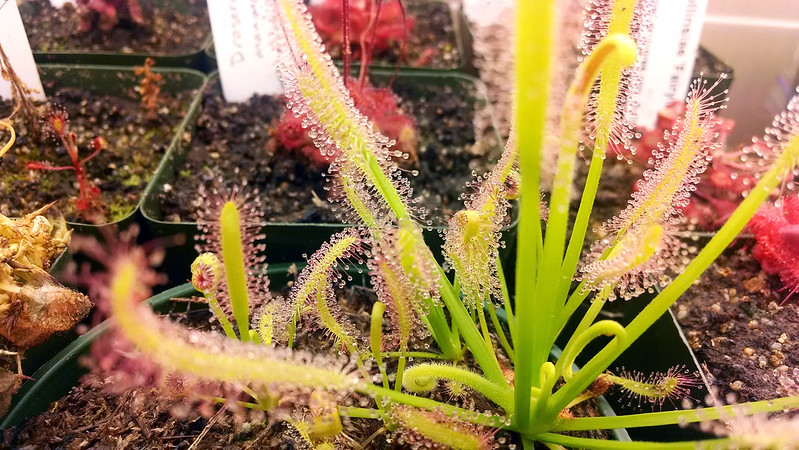I usually wait a little bit to post about new plants I acquire, since you want to make sure they're not going to just immediately croak in your conditions. It's happened to me a couple of times that I get a plant in the mail, it looks awesome for a day, and then it withers into nothing. One thing I've started doing to mitigate this is using humidity tents on any new plant I receive in the mail. That way if the plant was use to substantially higher humidity than my conditions provide it can be hardened off gradually without going into shock.
Drosera cistiflora is a relatively recent addition to my collection – I received it a little over 3 weeks ago, after winning it in an auction on the
Carnivorous Plant Auctions and Sales Facebook group, and it has bounced back tremendously from shipping.
 |
| So much dew on this D. cistiflora. |
 |
| Is it thinking about starting a stem? |
I'm almost done hardening this guy off. Look at that great dew, and that touch of red in the tentacles. Excellent! For a humidity tent I use a sandwich-sized Ziploc baggie fit over the pot. I harden off the plants by first cutting off one corner, then the other, then opening the top all the way, then cutting down the sides of the baggies, then finally removing it all together. The whole process usually takes 2 weeks or so, and the plants seem to do just fine.
About a week after I received the
D. cistiflora I completed a trade with another California grower who was looking for
Pinguicula gigantea. I sent him a large offset, along with a couple Utrics, and he sent me a few plants in exchange. These cute little starts of
Pinguicula cyclosecta and
Pinguicula 'Florian' were part of the exchange.
 |
| Baby Pings: the only thing cuter than mature Pings? |
 |
| This cultivar grows up to have very lovely scalloped edges. |
These are little babies. I harden Pings off much more quickly than I do
Drosera, since Pings are usually comfortable with lower humidity over all. These guys are almost done.
He also sent along a big clump of
Drosera ×
snyderi, which is a botanically invalid name for
Drosera dielsiana ×
nidiformis (an Ivan Snyder hybrid). I wonder if the fact that most people agree that the
Drosera dielsiana in cultivation is mostly
Drosera natalensis means that this plant is actually
D. natalensis ×
nidiformis. This is the nitty-gritty of plant collecting.
 |
| This is kind of a lot of plants. |
There's some decent dew on these guys, though they're taking their time a bit. The dividing and repotting process was a bit tougher on this group of plants, so that makes sense.
The last plant I received in that trade was a green form of
Drosera burmannii from the Hann River in Kimberley, WT, Australia. I've been wanting a green form of
D. burmannii for a while, so this was very exciting.
 |
| What a looker. |
This little dude started out all green with pale tentacles, but the tentacles have since reddened up and made this a really breathtaking plant. Just look at it! I can't wait to start feeding it heavily and seeing what it looks like all grown up.
Finally, just yesterday I met up with a grower from the eastern reaches of the Bay Area (hi Rose!) to swap a couple of plants. She got several
Drosera plants and some gemmae, and I got several Ping starts and this lovely little
Sarracenia psittacina.
 |
| My first S. psittacina! |
Apparently in the summer this plant gets a really nice red color. I'm already getting started filling up those lagoons!

















































